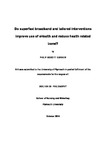Do superfast broadband and tailored interventions improve use of eHealth and reduce health related travel?
| dc.contributor.supervisor | Jones, Ray | |
| dc.contributor.author | Abbott-Garner, Philip | |
| dc.contributor.other | Faculty of Health | en_US |
| dc.date.accessioned | 2017-07-03T14:12:17Z | |
| dc.date.available | 2017-07-03T14:12:17Z | |
| dc.date.issued | 2017 | |
| dc.identifier | 10241449 | en_US |
| dc.identifier.uri | http://hdl.handle.net/10026.1/9587 | |
| dc.description.abstract |
Do superfast broadband and tailored interventions improve use of eHealth and reduce health related travel? Introduction – eHealth has been shown to have promising health outcomes in numerous areas, however many people remain digitally excluded and therefore suffer an inequality in health service provision. Lack of internet infrastructure, personal skills, and service provision have been identified as potential barriers to eHealth but as yet there is no good evidence of the significance of these barriers and the impact of interventions to improve them. This PhD aimed to assess impact on eHealth uptake of three interventions (i) superfast broadband, (ii) a tailored booklet to help participants improve personal internet skills and support, (iii) GP interventions to improve health service provision of eHealth. A subsidiary aim was to assess the impact on miles travelled. Methods - In a cluster quasi-randomised factorial controlled trial, 1388 households from 78 postcodes were sampled in 2013 from the 20088 Cornish postcodes and allocated to the 8 (2X2X2) arms of the study. A unique sampling method was used to prevent contamination between arms. Comparison of ‘eHealth readiness’ and ‘miles travelled’ from baseline to 18-month follow-up between the 8 arms of the study was used to assess the impact of interventions. Interventions were tailored based on responses from the initial baseline survey and designed using aspects of the theory of diffusion of innovations. An overall eHealth Readiness score (0-10) was obtained from a validated self-completed questionnaire combining four sub-scales (Personal, Provision, Support, Economic). The standard deviation of the eHealth Readiness score represents a measure of eHealth inequalities. Findings – No significant differences were shown between each intervention arm of the study, either singly or in combination (all p>.05). eHealth Readiness significantly improved over the 18-month trial period (M=4.36 vs M=4.59, t(235)=4.18 p<.001, CI=0.13-0.35). This increase is evidenced by increases in Personal and Provision scores (t(255)=3.191 p=.002, t(258)=3.410 p=.001). There was no change in eHealth inequality. The proportion of internet users, mobile use and happiness with internet speed also increased. Average travel to GPs did not significantly differ between baseline and follow-up (12.3 vs 13.0, t(251)=.44, p=.66). No correlation was shown between eHealth Readiness and total travel miles to GP practices. Discussion – Individuals within Cornwall became more ready to adopt eHealth services over the 18 months of study, increasing in both their personal ability to use eHealth and their methods of access. This increase did not cause a larger digital divide. However, this increase could not be attributed to any of the three interventions. Further research should focus on making use of the improvement of infrastructure within Cornwall and seek to implement eHealth services. The eHealth readiness of Cornwall should be assessed in a longitudinal study to understand the effects of time of the superfast rollout. Qualitative studies should take place on persons of interest to help design more effective interventions with the aim to achieve a societal drive to sustainable use and adoption of eHealth. Contribution to knowledge – Previously internet infrastructure has been acknowledged as a barrier to eHealth. This PhD was the first to analyse the impact of a high-speed internet rollout alongside other interventions on eHealth readiness. The methods in this study were unique and provide the basis for further work, both in the creation of a sampling method to reduce contamination between cluster interventions and as the first time a measure of eHealth readiness and eHealth inequality has been used to assess the effectiveness of eHealth interventions. | en_US |
| dc.description.sponsorship | Superfast Cornwall | en_US |
| dc.language.iso | en | |
| dc.publisher | University of Plymouth | |
| dc.rights | CC0 1.0 Universal | * |
| dc.rights.uri | http://creativecommons.org/publicdomain/zero/1.0/ | * |
| dc.subject | eHealth | en_US |
| dc.subject | telemedicine | en_US |
| dc.subject | Quasi RCT | en_US |
| dc.subject | Cluster | en_US |
| dc.subject | PERQ | en_US |
| dc.subject | ehealth readiness | en_US |
| dc.subject | Travel | en_US |
| dc.subject | CO2 | en_US |
| dc.subject.classification | PhD | en_US |
| dc.title | Do superfast broadband and tailored interventions improve use of eHealth and reduce health related travel? | en_US |
| dc.type | Thesis | |
| plymouth.version | publishable | en_US |
| dc.identifier.doi | http://dx.doi.org/10.24382/473 | |
| dc.rights.embargoperiod | No embargo | en_US |
| dc.type.qualification | Doctorate | en_US |
| rioxxterms.version | NA |
Files in this item
This item appears in the following Collection(s)
-
01 Research Theses Main Collection
Research Theses Main



